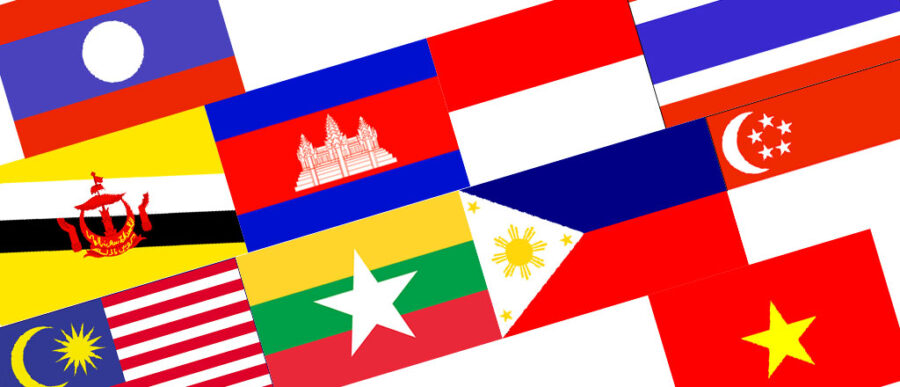The 620 million people living in the Association of Southeast Asian Nations, or ASEAN, are facing some potentially big changes in coming months, given lower oil prices and the formation of a regional economic community. The net impact is far from certain, however, and forming an economic community is no panacea, as anyone familiar with the tribulations of the European Union knows. Still, the planned launch of the ASEAN Economic Community (AEC) at the end of 2015 is likely to help sustain rapid economic growth in the medium term, analysts say. And the recent decline in crude oil prices to their lowest level in more than five years also will boost most ASEAN countries that are net importers of oil.
Various research institutes estimate that ASEAN could double its combined GDP by 2025 thanks to the AEC. But there are obstacles to liberalizing ASEAN’s financial service industries and capital markets, and to the movement of skilled labor, among other issues. Some of the less developed ASEAN countries, such as Cambodia, Laos, Myanmar and Vietnam (CLMV), will be slower to achieve their targets for trade liberalization, and the economic development gap between the CLMV and the other six, more affluent ASEAN countries (Brunei, Indonesia, Malaysia, the Philippines, Singapore and Thailand) remains wide. Moreover, the risk of political instability looms, especially in Thailand and Myanmar.
The Asian Development Bank (ABD) in December estimated GDP growth in developing Asia at 6.1% in 2014, down from its 6.2% forecast in September, and for 2015 it lowered its forecast to 6.2% from the previous 6.4%. The ADB also cut its GDP forecast for the 10 Southeast Asian countries to 4.4% in 2014 from its earlier forecast of 4.6%, and to 5.1% for 2015 from the earlier 5.3%. “While growth in the first three quarters of [2014] was somewhat softer than we had expected, declining oil prices may mean an upside surprise in 2015 as most economies are oil importers,” said ADB chief economist Shang-Jin Wei.
Oil remains one of the wild cards for the region, as well as for the global economy. Saudi Arabia said in December that it would not cut output to prop up oil markets even if non-OPEC nations do so, signaling that the world’s top petroleum exporter plans to ride out the market’s biggest slump in years. “There will be some losers and some winners in ASEAN, depending on whether they are net exporters or net importers, because of lower oil prices,” says Wharton finance professor Franklin Allen. “It seems that the price fall is here to stay since the Saudis decided that they want low oil prices so they do not get gradually squeezed out.”
Lower oil prices will help some ASEAN oil and gas importers like Thailand, which is the biggest beneficiary in Asia because it is the most dependent on road transport. Lower oil prices hurt Malaysia, a net oil exporter, and Myanmar, which is a net gas exporter. But IHS Economics Asia Pacific economist Rajiv Biswas nevertheless expects Myanmar’s growth to moderate only slightly to 7.6% in 2015 from 7.8% in 2014.
Regional Upswing Overall
London-based Capital Economics is forecasting emerging Asia’s regional GDP growth will rebound to 4.7% in 2015 from an estimated 4.3% in 2014 since most countries will benefit from lower oil prices and loose monetary policies, along with a gradual recovery in global demand. “We expect Thailand’s growth to pick up from 1% in 2014 to 3.5% in 2015,” says Daniel Martin, a senior economist at Capital’s Singapore office. “A lot of that is rebound from the political crisis. We are still slightly below the consensus this year because we think Thailand has some debt issues. It ran up a lot of credit growth rapidly over the last five years. We think that is going to be a drag this year and for a couple years after that.”
ASEAN has “liberalized trade in goods, but they still have big differences over liberalizing trade in services and liberalizing investments in the service sector, and allowing greater labor mobility.” –Ryo Ikebe
In Indonesia, the region’s biggest economy with 40% of its total GDP, the situation is even more complicated. Although it is a resource-rich country that used to export large quantities of oil, Indonesia is now a net oil importer and the slump in natural gas prices and commodity prices is hurting. “The changes in global commodity prices will be a net drag for Indonesia. We expect its growth to be stuck at about 5% this year, unchanged from 5% in 2014, as the country [implemented] a quite tight monetary policy,” Martin says.
Biswas expects Indonesia’s growth to remain stable at 5.1% in 2015, unchanged from 2014. “There is some better news in some other countries like Thailand,” he adds, although he is not as bullish as Martin. “Thailand was weak in 2014 because of all of the political problems in the first half of the year and the economy was almost in recession. Our estimate of growth in Thailand last year was 0.5% and very weak. We expect some improvement in 2015 because the military government announced a big stimulus package in October.” Biswas expects GDP growth of 2.9% in 2015. “[The better economic growth in Thailand] is important because from 0.5% to 2.9% growth for the second-biggest economy will have quite a significant effect on overall ASEAN growth.”
Malaysia, ASEAN’s fourth-biggest biggest economy, has been performing well — up 5.9% last year. But lower oil prices will take a bite this year since the country is an exporter of both oil and gas.
“What we are going to see this year is that government revenues will be affected because they are quite dependent on oil and gas revenues,” Biswas says. However, the impact will not be huge because Malaysia’s economy is more diversified, with strong tourism, and also manufacturing and exports of electronics. “We think the growth will be 4.8% [this year], a bit softer.”
Martin is optimistic about prospects for the Philippines. “We expect 6.5% growth this year and 6% in 2014 because their manufacturing sector is doing well and it is attracting foreign manufacturers from China.” The ADB downgraded its forecast for the Philippines slightly for 2014 to 6% from 6.2% after growth in the first nine months of the year reached only 5.8%. “Continued strong household consumption bolstered by steady growth in remittances and increases in domestic employment will, along with improved government spending, support the pickup in growth next year, the ADB said in a December report.
Vietnam likewise is doing fairly well, having increased its electronics exports to help balance out any impact from lower oil export revenues. Martin puts growth at 6% this year from 5.8% in 2014. “So much depends on what would happen to the banking sector, which has been a real drag,” Martin notes. “Credit growth has been much slower. I think there are quite a lot of issues behind that recapitalization of the banks, some bank mergers and consolidation factors.”
“[ASEAN] is a tremendously diverse group, from very poor to quite rich countries, so it will be tricky for them to make [the financial portion of the regional economic pact] work.” –Franklin Allen
‘Frontier’ Economies
As for the other ASEAN “frontier economies,” the outlook is for continuing strong growth. Biswas expects 7.4% GDP growth in 2015 for Laos and 7.7% in 2016, compared with an estimated growth of 7.3% in 2014. Myanmar, which is starting from a much lower base than its neighbors, will see growth at 7.6% in 2015 and 7.3% in 2016, compared with 7.8% estimated growth in 2014, Biswas says. He predicts Cambodia to have 8.2% growth in 2015 and 8.1% in 2016, up from 7.8% in 2014.
Despite the various uncertainties, growth is expected to remain strong. In its “ASEAN 2025 Survey Report,” the Japan International Cooperation Agency (JICA) forecast that the region’s GDP will grow by 5% a year, doubling to $4,628 billion in 2025, with Indonesia, Thailand, the Philippines and Malaysia accounting for more than 70% of total GDP. “Other international organizations like the ADB have similar forecasts for ASEAN by 2025,” says Koichi Ishikawa, a professor at Asia University and an ASEAN expert. “Unless something unexpected happens, they will be able to double their GDP by 2025.”
As population growth slows, GDP per capita will also rise, growing between 8% to 9% for the developing countries and 3.5% to 6.5% for the ASEAN 6. JICA expects ASEAN’s population to increase 1% annually from 2015 to 2025 to reach 695 million by the end of 2025. Meanwhile, the size of the middle- and higher-income classes will increase to 76.5% by 2025 from 56.4% in 2010.
Experts are divided over the impact of the AEC for mid-term ASEAN economy. Ryo Ikebe, director of Asia and Oceania division at the Japan External Trade Organization and an ASEAN expert, says the launch of the AEC later this year is only the beginning of a long process of market opening. “They have liberalized trade in goods, but they still have big differences over liberalizing trade in services and liberalizing investments in the service sector, and allowing greater labor mobility,” Ikebe notes. “The main six ASEAN countries have abolished tariffs on 99% of items of goods trade, so that is almost completed. But we have to see how far Cambodia, Laos, Malaysia and Vietnam will go in following the ASEAN 6 by 2018.”
For countries that are just beginning to build capital markets and modern financial systems, the process will be more complicated. “It is a tremendously diverse group, from very poor to quite rich countries, so it will be tricky for them to make this work,” says Allen, who also is a professor at Imperial College in London and head of its Brevan Howard Centre for Financial Analysis.
ASEAN will make significant progress and that will accelerate growth, but full market opening is unlikely to occur by the December 31, 2015, deadline, says Murray Hiebert, a senior fellow and deputy director of the Sumitro Chair for Southeast Asia Studies at the Center for Strategic and International Studies (CSIS)in Washington, D.C. “Liberalization in financial and other services, freer capital flows and labor mobility are expected to lag behind. In many ways, the deadline is more aspirational than binding; the grouping’s leaders never thought that less-developed economies like Laos and Myanmar would achieve all the integration goals by the end of 2015,” Hiebert notes. “Even some of the more developed economies like Indonesia will struggle to meet all of their targets.”
Liberalizing financial services would foster more resilient economic growth, Hiebert adds. “But some ASEAN countries are anxious about opening up financial services and capital markets out of fear of financial contagion and exchange rate volatility, even though integration would provide opportunities for risk sharing.”
“Some ASEAN countries are anxious about opening up financial services and capital markets out of fear of financial contagion and exchange rate volatility, even though integration would provide opportunities for risk sharing.” –Murray Hiebert
Market opening implies an acceptance, to a certain extent, of a division of labor, and there will be losers and winners in various industries, says Ikebe. “For example, you will not be able to have a car industry in [all] 10 countries. One or two countries will have an auto industry or electronics industry. There will be a clear ranking in terms of manufacturing industries among the AEC countries and there will no longer be tariff protection after the launch of AEC.”
While the plans for AEC are transparent, trade arrangements with other ASEAN partners are more complicated and obscure. The RCEP, or Regional Comprehensive Economic Partnership, joins the ASEAN countries and six other major regional economies, which have free trade arrangements. RCEP is intended mainly to harmonize differences between those various trade agreements. “It is hard to calculate the impact of the RCEP on economic growth because the negotiation partners have not been transparent in spelling out exactly what issues they plan to tackle in the agreements. That said, harmonizing differences between the different agreements with ASEAN will still benefit the regions,” Hiebert says.
The potential impact from trade talks among the dozen Pacific Rim countries in the Trans-Pacific Partnership is even less clear. Vietnam, Brunei, Malaysia and Singapore are members of the U.S.-led effort, which also includes Japan, Chile, Peru, Mexico, Canada, New Zealand and Australia. Extending the free trade arrangements of RCEP would be a natural progression, says Biswas. “TPP is more complicated because of other major partners like the U.S., which is not in RCEP. So implementing the building blocks for RCEP can be done soon, though there are still doubts over when TPP will be implemented.”
In Myanmar, apart from trade dealings, ASEAN faces two major political sources of uncertainty. Parliamentary elections are due late in the year, and the country is struggling with violence between majority Buddhists and the minority Muslim Rohingyas, as well as significant economic challenges. “Myanmar is still only a minor player in ASEAN’s economy so it is not likely that the election in 2015 will have a major impact on ASEAN,” Hiebert says. “But Thailand’s political instability could have a bigger impact, particularly if it delays Thailand’s ability to meet AEC goals. More political instability is also possible in Thailand if the military, which has already said it will delay elections from late 2015 to 2016, postpones the elections indefinitely. This could prompt protests and result in more instability and economic turmoil.”
No Currency Unification
Even if the AEC launch goes smoothly, the result will not be a unified market along the lines of the European Union (EU), experts say. “EU members give up their national sovereignty in terms of issuing their own currencies and trade, and hand it over to EU,” says Ishikawa of Asia University. “ASEAN is different and the different sovereign nations are cooperating to liberalize their markets. They do not plan to unify their currencies.”
In many respects, a unified economic community remains a distant prospect for the collection of developing nations within ASEAN markets scattered among the archipelagos and mountainous peninsulas of Southeast Asia. The economic and demographic gaps in the region are vast. “For example, Indonesia’s population is 600 times bigger than Brunei’s. In terms of GDP per capita, Singapore’s is the highest and is 63 times bigger than Myanmar’s,” Ikebe notes.
Perhaps the biggest challenge will be in integrating policies of countries with vastly differing political systems. “For example, democratic Indonesia has to be more responsive to the demand of domestic business, NGOs and labor unions than does more authoritarian Singapore,” says Hiebert. “This is one reason why ASEAN has no interest in forming a single market with a united currency like that in the EU.”



